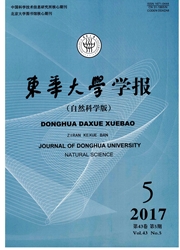

 中文摘要:
中文摘要:
为了寻求通过测量光学信号计算各种纺织纤维集合体的面密度分布的准确方法,针对纺织纤维对光具有吸收、反射和散射的特性,基于Kubelka-Munk双通道模型透射公式,推导出通过光学信号计算层状纤维集合体任意一点处的相对面密度的算法,称为Wu-Wang(W-W)透射算法.采用已知面密度的棉纤维和羊毛纤维试样各一组,借助数码光学元件搭建的装置测得纤维层的透射光图像,以W-W算法计算出各试样的相对面密度,发现与其他方法测试的基准面密度高度吻合.并与Lambert-Beer模型的计算结果作比较,证明W-W算法获得的光学相对面密度与真实面密度非常吻合,验证了此面密度算法表征的相对光学面密度的准确性.W-W新算法可以广泛应用于纤维长度分布和多种结构的纤维集合体面密度的测量.
 英文摘要:
英文摘要:
To search for an accurate method to calculate the area density distribution of all kinds of fiber assemblies by the measured optical signal, and considering textile fibers' properties of absorption, reflection and scattering, a new optical transmission algorithm that called Wu-Wang(W-W) algorithm was derived. This new algorithm was based on the transmission formula of Kubelka-Munk model and the relative area density at any point of layered fiber assemblies can be calculated. A group of wool and cotton fiber samples were used as test samples, whose base area densities are already known. The transmission information of the fiber layers were measured by a laboratory device which was set up by digital optical elements. The relative optical area density of the test samples that was calculated by W-W algorithm from the transmission information is nearly equal to the results of other methods. This relative optical area density was also compared with the result of Lambert-Beer model. The results show that the optical relative area densities by the new built transmission algorithm are closer to the real ones, which proves the accuracy of the optical relative area densities calculated by the W-W algorithm. The new built W-W algorithm can be used in the measurement of fiber length distribution and area density of differentconstructions of fiber assemblies.
 同期刊论文项目
同期刊论文项目
 同项目期刊论文
同项目期刊论文
 期刊信息
期刊信息
